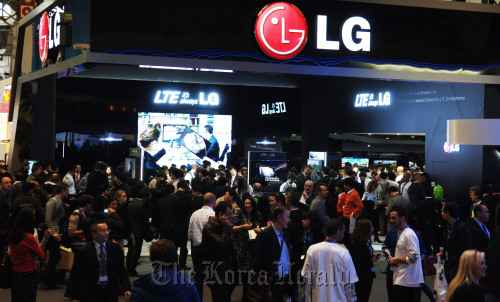Korean tech firms admit gap is fast narrowing
BARCELONA, Spain ― Amid the absence of the world’s largest smartphone maker Apple, Korea’s Samsung and LG ― the market No. 2 and 3 respectively ― were dominant players during the Mobile World Congress that ended Thursday in Barcelona.
But the companies that made a real impression at the industry’s largest trade show this year were Chinese vendors such as ZTE and Huawei.
Huawei rebranded itself as a high-end handset maker, touting its quad-core phone Ascend D as the world’s fastest smartphone, while ZTE followed with 15 new phone announcements.
Both the companies were also the key sponsors of the MWC, blanketing Barcelona with their posters and ads.
Exhibition hall 8, which used to be dominated by European and American companies, now provides its showroom space to Chinese firms as well as Korean big names Samsung, LG and SK Telecom, the nation’s largest telecom operator.
“I can understand the nervousness that European and American companies may have felt from Korean players 10 years ago,” said an official from a Korean company on condition of anonymity.
“We were fast in overtaking our rival companies. But the Chinese are growing even faster.”

 |
Booths of Samsung (above) and LG attract vistors at the Mobile World Congress held in Barcelona,Spain. (Park Hyun-koo/The Korea Herald) |
According to global market research firm Gartner, ZTE and Huawei rose as the world’s fourth and sixth-largest handset makers in the final quarter of last year in terms of sales. Korea’s Samsung and LG stood at second and fifth, respectively, during the same period, the global market research firm said.
On his visit to the Samsung booth next to that of ZTE, Samsung Electronics CEO Choi Gee-sung commented on the Chinese rivals.
“Even before we announce new products, they roll out similar products. Many of the visitors here also are coming from rival companies,” he said.
“They could be able to copy the appearance. But it would be difficult to copy the core.”
Samsung delayed the unveiling of the successor to its global hit smartphone Galaxy S II at this year’s MWC, citing the timing gap between its announcement and official launch.
Huawei and ZTE may be unfamiliar to many consumers as they still see much of their business from their home market of China. During the MWC, however, their new mobile devices demonstrated that the companies are serious about becoming major global players.
Huawei, especially, confirmed its presence by introducing its first quad-core phone at the same time as Korea’s LG and Taiwan’s HTC.
The quad-core phone contains a multi-core processor with four independent processors and results in faster overall computing and applications speeds.
While LG and HTC use an Nvidia Tegra 3 chipset, the Ascend D Quad has a chipset manufactured by Huawei.
“It’s 49 percent faster than the fastest smartphone in the world,” said Richard Yu, the chairman of Huawei Device, referring to the Samsung Galaxy S II.
“Our brand is not so famous, but our devices are the best,” he said, expecting that the phone would help the company stand out among its competitors this year.
In China, Huawei has only about seven percent of the smartphone market, behind ZTE, Apple, Samsung and Nokia.
“Huawei’s rise is impressive,” said an official from LG, which introduced the Optimus 4X HD, another first quad-core smartphone that has four plus one cores ― the fifth takes over background processes for better battery performance.
“When it comes to the user interface, however, I think the software needs to be improved for customized services. But we are not so sure when Chinese firms could catch up with us,” he said, declining to be named.
Another company official also expressed nervousness even though he admitted that Chinese firms were not an immediate threat.
“Until last year, I thought Chinese products still had a long way to go. Now their gap with us seems to be narrowing steadily based on the soaring domestic market,” he said.
Meanwhile, the four-day conference and exhibition attracted 67,000 visitors from 205 countries this year, a new record for the annual event. Of them, more than 3,500 were CEOs from the world’s most influential mobile operators, equipment providers and Internet companies.
By Lee Ji-yoon, Korea Herald correspondent
(
jylee@heraldcorp.com)









